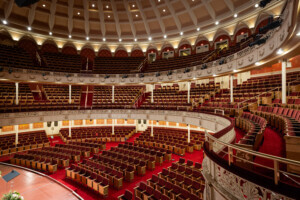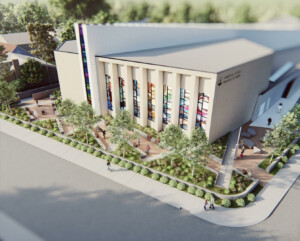[ Editor’s Note: Peter Murray, of the New London Architecture Center, together with a dozen architects and planners, is biking from Portland, Oregon to Portland Place in London, studying how cities are responding to the demand for better cycling infrastructure. He reports from the start of his ride. The Architect’s Newspaper is USA media sponsor of the trip and will post periodic updates of these architects on bicycles. As the P2P team gears up for its triumphant arrival in Manhattan on Sunday (June 30th) having completed the U.S. leg of the trip, Peter Murray looks back at some of the highlights of the last week’s riding. ]
One of the delights of cycling across the States has been to experience cities whose names were familiar to me but whose contemporary characteristics and qualities were a void. I am ashamed to admit that when first researching our route through Pittsburgh my main ideas of the city were influenced by scenes of Pennsylvania’s shrinking steel industry from Michael Cimino’s 1978 film The Deerhunter. Instead, I found that Pittsburgh is “the regeneration capital of the U.S.,” eds and meds have replaced steel and it has a fast-improving bicycle infrastructure. Much of the credit for this last piece of progress must go to the energy of Scott Bricker and Lou Fineberg who founded Bike Pittsburgh just over a decade ago. The city still has a long way to go but it has bike lanes and riverside trails and it is highly probable that the next Mayor will be the Democrat Bill Peduto, who is a strong supporter of better biking. Of buildings in the city, we much enjoyed H. H. Richardson’s powerful Allegheny Courthouse and Jail with its rough stone masonry and Romanesque detailing.
Columbus, Ohio was another city I knew little about and often confused for Columbus, Indiana. We managed to find Peter Eisenman’s seminal decon Wexner Centre with its crashing grids, iconic plan, and instantly recognizable “chess piece” turrets. Passing Eisenman’s new convention center in the city, one gets the impression that he is more comfortable working at the smaller scale of the art gallery rather than the multiblock behemoth of the convention center.
I left the ride for a few days to fulfill a speaking engagement in London and planned to rejoin the cyclists in Cincinnati and flew to Indianapolis confident that I could take the train to Cincinnati. However it turned out that they only run three times a week! The consequences of—to a European eye—the States’ appalling underinvestment in rail transport can be seen in the striking Cincinnati Union Terminal. A giant juke box of a building designed by Alfred Fellheimer and completed in 1933. It has largely been taken over, perhaps appropriately, by an exhibition about dinosaurs, with one small side platform allocated to the trains.
Zaha Hadid’s Contemporary Arts Center in Cincinnati is (for her) a restrained building which sits happily in the city block, although internally rather too much has been squeezed into too small a space. Michael Graves’s Engineering Center over at the University of Cincinnati was very grand, and I was surprised to hear later that Bernard Tschumi had designed one of the sports building which I had passed by without realising it had such a pedigree. We cycled round the Over-the-Rhine district, scene of the 2001 riots and now an area of major regeneration which reminded us of similar areas in London like Shoreditch and Spitalfields.
Indianapolis has also gone through major regeneration in recent years, it has a vibrant downtown area, new convention center and the massive Lucas Oil Stadium designed by HKS with a brick facade that dominates the city. The architects used bricks to relate to the historic core but there was little they could do about the size of the building. The piece of design that most attracted us as cyclists was the the landscaping and bicycle paths. These have been designed to reflect their relationship with the city rather than selected from the stabdard traffic engineer’s catalogue.
I struggle in each of these cities with the number of car parking sites which leave huge gaps in the urban fabric and destroy any feeling of place. In Cincinnati this has been ameliorated by a program of murals on blank walls, but maybe as more people take to bicycles and demand for car parking space reductions they will be developed to form a coherent part of the city.










